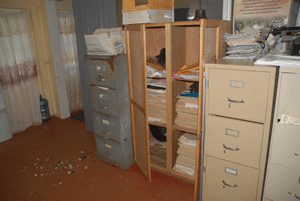PRESIDENT Donald Ramotar yesterday reaffirmed his administration’s commitment to providing all Guyanese with equal access to education, while disclosing that Government is currently looking to offer some University of Guyana degree programmes online to allow Guyanese in the remotest parts of the country to have access to tertiary education.
 Addressing thousands of students at the Rally for Education, held under the theme ‘Transforming classrooms for the 21st century’ in the National Park in Georgetown as part of Education Month 2013, President Ramotar said: “I know no better way of providing equal opportunities for all our people than by giving all our people access to the best education that we can provide.”
Addressing thousands of students at the Rally for Education, held under the theme ‘Transforming classrooms for the 21st century’ in the National Park in Georgetown as part of Education Month 2013, President Ramotar said: “I know no better way of providing equal opportunities for all our people than by giving all our people access to the best education that we can provide.”
He alluded to the fact that the largest allocation in the country’s budget is in the social sector, and that the education sector, as part of the social sector, is receiving the largest allocation.
According to Guyana’s Head of State, Science and Technology are already playing huge roles in the development of the Guyanese society, and societies as a whole, and this is expected to grow even more in the future.
As such, he said, Science and Technology should be utilised in education.
Assuring his audience that Government continues to work on development of the Information and Communication Technology (ICT) sector, the President said his administration is also moving to equip all se
ondary schools with ICT laboratories, so that students can have even more possibilities for research and development.
President Ramotar alluded to the One Laptop Per Family (OLPF) initiative, which sees the Government trying to give every family, regardless of their economic circumstances, the most modern of tools. He said this was designed to ensure that no mind or resource was wasted in Guyana.
The Head of State proclaimed that Guyana is the only country in the Caribbean which has a learning channel, and he makes it a point wherever he goes in the country to find out if the transmission is reaching the various areas.
Ramotar related that, from what he has been told, the Guyana Learning Channel is making a very important contribution to the development of education in the country, which is very important.
He indicated that Guyana has achieved the Millennium Development Goal of universal primary education, and disclosed that he is very proud of this milestone. “Every child in our country has the possibility of having a full primary education, and we are working hard to ensure that, no matter where you are from, either in the cities, in the villages, on the coastland, or the remotest areas in the interior, we are working to ensure that we bring universal secondary education to our country,” he asserted.
The President said his administration is building a new secondary school in Kato, Region 8 (Potaro/Siparuni), and another one is slated for construction in the Upper Mazaruni area, because his administration is serious about providing equal opportunity for all Guyanese.
Alluding to the criticism that Government has encountered in the education sector, he said that persons must also recognise the successes and achievements attained in that sector. He said the proportion of trained teachers has risen from 58 percent five years ago to 70 percent today, and this result has been due to various factors.
The President proclaimed that, as a result of the investments made by the current Government in the education sector over the years, a significant increase in the number of students attending school has been seen. He highlighted programmes — such as the school uniform voucher programme, the school feeding programme, as well as the provision of text books and exercise books – which have been instrumental in this regard, and said there has also been an increase in the number of graduate teachers at the primary level, which is very important since the administration believes that the foundation laid at this level is extremely important to take students forward.
President Ramotar said that when figures are examined, there has been an increase in the number of male students remaining in school.



.jpg)








